the history of yeovil's pubs
PUBS HOME PAGE |
PUBS INTRODUCTION |
PUBS BY NAME |
BEERHOUSES |
greyhound inn (2)
8 South Street
Yeovil's first Greyhound Inn was located in the Borough. The Greyhound under discussion here was Yeovil's second Greyhound Inn, in South Street, marked 'I' on the map below. The building it occupied must have been built after 1806 as Watts map of Yeovil of that year shows the site occupied by the Greyhound Inn as empty space. In any event as far as I'm aware it didn't begin trading until after 1842 since the Greyhound in High Street was listed as still trading at this date.
As the first photograph below, taken around 1880, shows the Greyhound has not always been in the building we see today. The original two-story building was a far simpler brick structure with mullioned windows under a thatched roof.
As seen in the photograph, immediately next door to the Greyhound was the Cow Inn and on the opposite side of the road was the Globe and Crown. The Cow Inn disappears from the records around 1905, probably as a result of the Licensing Act 1904 combined with the death of its last licensee.
It was thought that both the Cow Inn and the old Greyhound Inn building were demolished at this time and the new Greyhound Inn building, much larger than its predecessor, was built to occupy much of both sites. However the aerial photograph below shows that while the Cow Inn disappeared for the construction of King George Street in 1928, the old Greyhound Inn building hung on for a few more years. The new building had replaced it by the 1950s.
One snippet that caught my eye took place in 1841 when two night watchmen. named Roan and Belben. were severely admonished for drinking in the Greyhound while on duty and consequently failed to deal with a disturbance. This seems to have been a particular problem with the watch at this period since watchman Charles Legg was dismissed for drinking in Charles Pottle's beerhouse in Wine Street called the Case is Altered in 1842. Indeed, in 1838 the Town Commissioners had passed the following resolution "Resolved that Notice be given to the Keepers of all Inns and Beerhouses in the Town that the penalty of the Act of Parliament will be strictly enforced against such of them who shall hereafter harbour any Watchmen during the hours of duty, and that a Copy of the Clause in the Town Act relating to this offence be sent with every such Notice. Ordered that 200 Copies of the Clause be printed."
In 1879 the Post Office Directory noted that Mr Bartlett ran a carrier service to Haselbury from the Greyhound every Friday and on the same day Mr Jeffery ran a similar service to Yetminster. Bartlett's service was continuing in 1882.
|
Yeovilians remember...
Thanks
to Will
Rich for
the
following
memories
-
"Interesting
that the
Greyhound
was seen
as a den
of
iniquity
(Hell's
Angels
etc). In
the
sixties
it was
definitely
an
underage
drinking
establishment,
mainly
populated
by mods,
and
notable
for its
bar
billiards
table. I
was not
actually
present
at the
time but
apparently
one
evening
the
local
rockers
invaded
and a
brawl
ensued
in which
the
rockers
were
well
trounced,
including
some who
had beer
glasses
smashed
over
their
heads."
....and finally, from Bernard 'Andy' Blackwell - "The Hotel was used by Eldridge Pope as a training house for managers; having a 28 seat restaurant, 4 letting rooms and the skittle alley that could be used for functions when not being used by either of the 2 skittle teams. The training manager was Mr (Bernard?) Tibble who, along with a Bernard Holcombe (Tied Trade Director of Eldridge Pope) were joint licensees of the Three Choughs and the Greyhound. They could dismiss the licensee much more easily, hence there not being a licensee of the Greyhound in the 1960s and 70s. My wife and I, Bernard and Julie Blackwell, became trainée managers in August 1973 and it should have been for 6 months but as Mr Tibble lost his License, due to fighting (and the local police superintendent wanting an excuse to get him out) at the Three Choughs and the Greyhound, a new manager and licensee was found and I was asked to stay another 4+ months since the new manager was not a qualified training manager. After we left Yeovil we moved to the Southbourne Cliffs Hotel in Bournemouth." |
The following is from the Western Gazette of 21 June 1991 and makes fascinating reading -
|
Police chief tells of worst pub in town A senior police officer has told magistrates a horror story of gang fights and violence and branded the Greyhound Hotel the worst pub in Yeovil. Inspector Tom Barron told Yeovil magistrates this week that the pub was a bolthole for local Hell's Angels known as the Reapers. He said the pub was infamous - the worst in town - and took up a disproportionate amount of police time. The pub is closed at present after a the application for a license was refused. Inspector Barron cited gang warfare and other incidents at the pub needing police action. They included a report of a Hell's Angel with a sawn-off shotgun, an attack at the pub by a gang - the "Yeovil 10" - resulting in the licensee's wife having her nose broken, armed members of the Reapers waiting for another Hell's Angels gang "to give them a spanking", frequent attempts by rival gangs to break up the pub, drinking after hours - until midnight on two occasions. Inspector Barron said of the gang fight "They wielded cues, threw snooker balls around and assaulted people in the pub." He said that when clubs had been found at the pub he refused to believe they were firewood. In recent weeks drinking after hours had taken place and he said that events at the pub were a horror story. He said "This pub is to licensing what pre-war pedal cycles are to interplanetary travel." And he accused prospective licensee Gary Moore of attending a licensing interview "well in his cups." Inspector Barron said "I was astounded when someone attended an interview well oiled and on the way to being drunk." Mr Moore told licensing magistrates he was not drunk but had a few half pints during his free time before the interview. He admitted that his first reaction when he saw the pub was that it was not worth taking on but he blamed the conditions on the previous licensee and said trade and the clientele had improved since he took over four weeks ago. He admitted "a few" Hell's Angels still used the pub but said they caused no trouble. Inspector Barron asked Mr Moore to explain people seen drinking in the pub around midnight on a Friday two weeks ago. Mr Moore said they had been friends visiting him. Inspector Barron said after-hours drinking had also taken place on the next night. Mr Moore denied it and Inspector Barron commented "We seem to be poles apart." He suggested that Mr Moore was not strong enough to take on the pub. On behalf of Eldridge Pope, licensing manager Richard Daubeney said there had been some problems at the Greyhound under the previous licensee who had now been dismissed. He said the pub had a chequered career which the brewery now intended to remedy. Refurbishment would change the theme of the pub, which would show a dramatic change. He said it was a tough proposition to take on but the clientele would improve. Mr Daubeney said Eldridge Pope had undertaken a survey on violence in pubs, including a report by an Oxford professor. Mr Daubeney said it showed "we cannot fight fire with fire. We do not need a licensee who can knock heads together but must use psychology." The magistrates refused the license. Afterwards Mr Moore would not come to the door of the Greyhound - closed for redecoration - to speak to the Western Gazette but he sent a co-worker with the message "He said he did not wish to comment but was very disappointed." Mr Daubeney said "Calling it the worst pub in Yeovil was a very unkind remark. It is a bit tired and needs refurbishing and this is already under way. It has a bad reputation but we are intent on changing its image. We hope to reopen it as soon as possible with a new manager." |
The following is from the Western Gazette of 26 August 2011 -
|
Proud to put hotel in place of drugs den A building in the centre of Yeovil that went from a popular pub to an eyesore and drugs den in recent years is to reopen as an upmarket hotel. The historic Greyhound pub on South Street was once a thriving night spot, known for lively parties and dancing on the tables. But it was one of a number of once popular Yeovil pubs which closed down in recent years. As many as 15 pubs have closed in the Yeovil area in the last decade as profits in the licensed trade dwindled. Following the pub's closure in 2003 the site faced an uncertain future and outbuildings became a home to vagrants and drug addicts. Planning permission was granted to redevelop the site into flats in 2007, but the work was never carried out. Instead husband and wife Isobel and Richard Brett of Yeovil have spent the last nine months carrying out a total transformation of the building. They have converted it into a ten-room hotel called The Keep which will be pitched mainly at business people visiting the town. The name is inspired by the imposing castle-like tower at one end of the building. |
![]()
The first recorded licensee was Job Osment who was born on 26 August 1821 at Nether Cerne, Dorset. In the 1841 census while living in Dorchester, Dorset, he was listed as a male servant and it was in Dorchester that he met Sophia Stoodley and they married in Poole, Dorset, on 20 December 1845. By the time of the 1851 census Job and Sophia had moved to Yeovil and Job was listed as a licensed victualler running the Greyhound in South Street and he was also listed here in Slater's Directory of 1852. When the Elephant and Castle opened in 1860, Job was its first licensee and he is listed as such in the 1861 census with Sophia. Sadly, on 2 April 1862, at the age of 40, Job committed suicide by leaping from a window of the Elephant and Castle - for the full story of Job's demise click here.
The Greyhound didn’t seem to be able to keep a landlord for more than a couple of years at a time. John Laver is found as licensee in the 1861 census with his wife, Jane. Born in Hinton St George around 1832, he was listed as a victualler in the 1861 census but seems not to appear in later records.
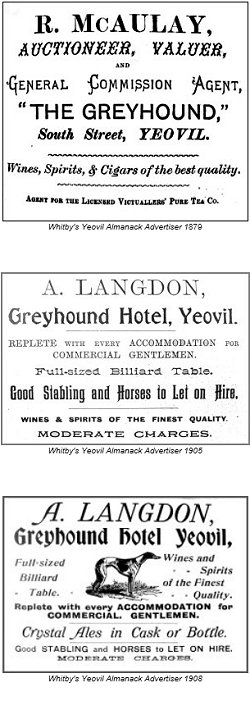 Robert
Allen was born
about 1824 in
Sherborne,
Dorset, the son
of painter
Richard Allen
and his wife,
Sarah. In the
1841 census
15-year old
Robert's
occupation was
given as a
painter's
apprentice and
ten years later,
still living at
home with his
parents and
eleven siblings,
he was listed as
a painter. By
the time of the
1861 census
Robert had
married Matilda
Catherine Buller,
had a son,
Robert junior,
had moved to
Yeovil and had
become licensee
of the Greyhound
where the census
listed him as a
victualler with
Matilda, their
son and her
mother living on
the premises
along with three
servants (a
house servant,
an ostler and a
nurse maid) and
two lodgers. In
the 1871 census
the only
differences were
three additional
children and
only one servant
and Robert's
occupation was
listed as
innkeeper. By
1881 Robert and
his family had
moved around the
corner and were
living in
Union Street.
Robert's
occupation was
now the manager
of a soda water
manufactory, and
still was ten
years later.
(The Mineral &
Soda Water Works
were located in
the building now
occupied by the
Pico coffee shop
in Union Street,
opposite what
used to be the
front entrance
to the police
station). In
1889 he was
listed in
Kelly's
Directory as the
licensee of the
Pall Hotel. Robert
died in
September 1900.
Robert
Allen was born
about 1824 in
Sherborne,
Dorset, the son
of painter
Richard Allen
and his wife,
Sarah. In the
1841 census
15-year old
Robert's
occupation was
given as a
painter's
apprentice and
ten years later,
still living at
home with his
parents and
eleven siblings,
he was listed as
a painter. By
the time of the
1861 census
Robert had
married Matilda
Catherine Buller,
had a son,
Robert junior,
had moved to
Yeovil and had
become licensee
of the Greyhound
where the census
listed him as a
victualler with
Matilda, their
son and her
mother living on
the premises
along with three
servants (a
house servant,
an ostler and a
nurse maid) and
two lodgers. In
the 1871 census
the only
differences were
three additional
children and
only one servant
and Robert's
occupation was
listed as
innkeeper. By
1881 Robert and
his family had
moved around the
corner and were
living in
Union Street.
Robert's
occupation was
now the manager
of a soda water
manufactory, and
still was ten
years later.
(The Mineral &
Soda Water Works
were located in
the building now
occupied by the
Pico coffee shop
in Union Street,
opposite what
used to be the
front entrance
to the police
station). In
1889 he was
listed in
Kelly's
Directory as the
licensee of the
Pall Hotel. Robert
died in
September 1900.
Charity Parsons was born about 1835 at Queen Camel, the daughter of Thomas Parsons and his wife, Ann. She was married to George Frederick Braine, a shoe maker of West Camel, who died in 1877. By 1881, as a 44-year old widow, Charity was the licensee of the Market House Inn, South Street where she was living with her 22-year old blacksmith son, Frederick John, known as Fred. By 1889 Charity was running the Greyhound Hotel in South Street and was still listed as the licensee there in the 1895 edition of Kelly's Directory, but she died in 1895 aged 60.
Now, really concentrate, as this is where it gets a bit complicated - after Charity died the license of the Greyhound was taken on by her son, Fred, and daughter-in-law, Annie, née Treasure. Fred Braine died in March 1897 and Annie married Frederick Langdon, licensee of the Cow Inn next door to the Greyhound, in January 1898. The couple ran both pubs until Fred Langdon's death in 1906. After this date Annie, now Annie Langdon, concentrated on running the Greyhound probably until her death in 1936, aged 74 - a total of about forty years. As a postscript, Fred and Annie's son, Frederick George, married Laura Beare who was the daughter of James Beare, the licensee of the Quicksilver Mail on Hendford Hill and after James' death in 1917, Fred and Laura ran the Quicksilver until the 1960's.
Annie Braine / Langdon was followed by Percy Hawkins as licensee from at least 1936 until 1954 and beyond. Percy Hawkins then moved to the newly built Green Dragon in St Michael's Avenue
map
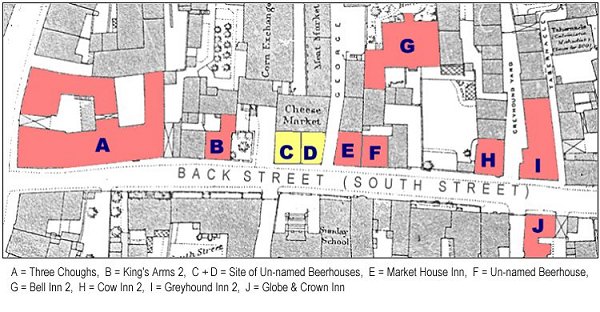
gallery
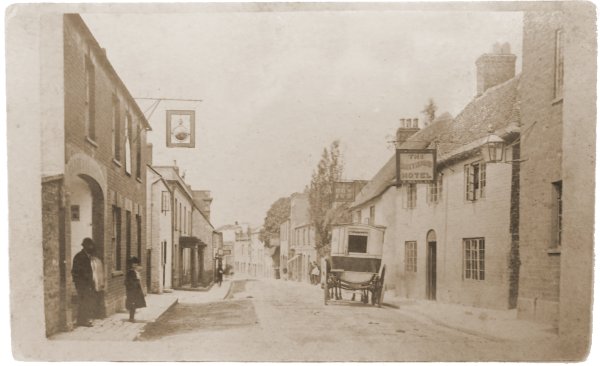
This photograph
features in my
book 'Yeovil
From Old
Photographs'
Taken taken before 1879, this photograph by Adam Gosney shows the Greyhound Hotel at extreme right (before being rebuilt in its present form), the Cow Inn next door, the Globe and Crown opposite and the Three Choughs Hotel in the far distance at the end of South Street. Between the Cow Inn and the Choughs was the two-storey King's Arms 2 in the far distance as well as a couple of un-named beerhouses. Then the three-storey Market House Inn and then another un-named beerhouse. Just think, what an ideal pub crawl. Note the horse-drawn omnibus parked outside the Greyhound.
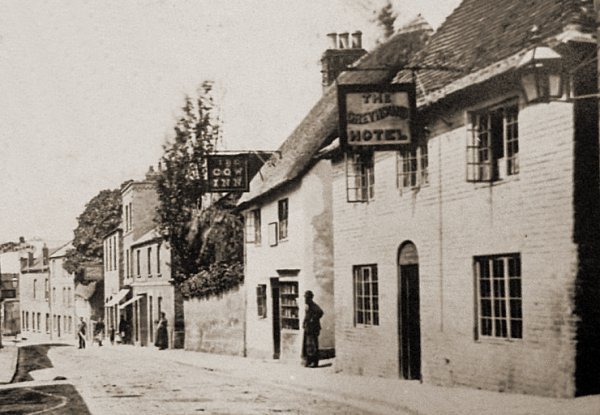
This photograph
features in my
book 'Secret
Yeovil'
Another photograph of South Street taken around 1880 showing the Greyhound Hotel and the Cow Inn. The man is standing at the entrance to Greyhound Yard, a small 'court' of low quality housing.
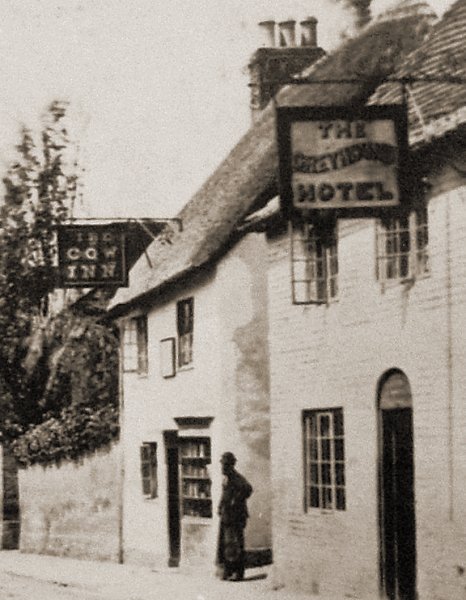
An enlargement of the previous photograph showing the Greyhound Hotel in greater detail - clearly brick-built under a stone-tiled roof
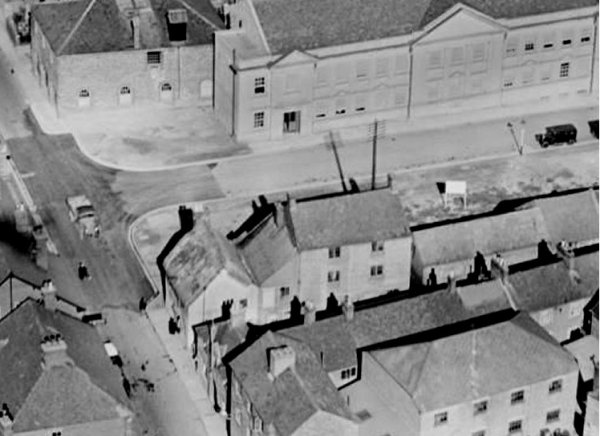
A 1928 aerial photograph showing the spanking new King George Street. At top left is the old Cheese Market, converted in 1913 to the fire engine house and next to it the Council offices facing the new road - note the absence of the post office, bank, etc. on the other side though! The Cow Inn has been demolished but the old Greyhound Inn building still stands.
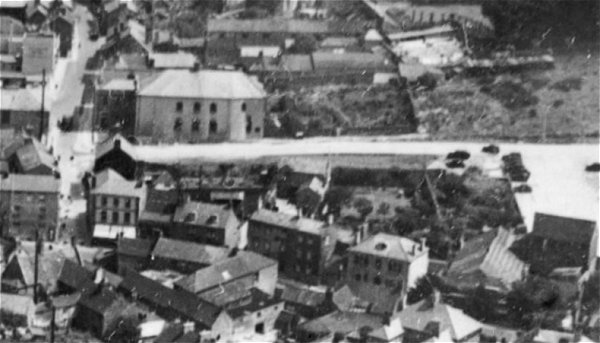
This aerial photograph dates to 1935 and shows Petters Way running across the photograph from South Street, at left, to the car park at right. Buildings of note are - the rebuilt Greyhound Inn at very top left, showing that it was rebuilt between 1928 (the previous photo) and 1935 (this photo). Also seen are the Baptist church at top left, the Three Choughs Hotel at centre left edge with the junction of South Street with Hendford to its right. On the opposite corner the buildings running along the east side of Hendford (with their street elevations facing us) are Chudleigh's seed merchants, the small shop that had been John Chaffin's photographic studio (later the WI Market), next to the Butcher's Arms. Next is Flower's House then Ayr Villa and finally the furniture emporium known as The Rink owned by Henry White. Note that in the top right hand corner is the field that the Yeovil Law Courts and Police Station would be built on three years later, in 1938.
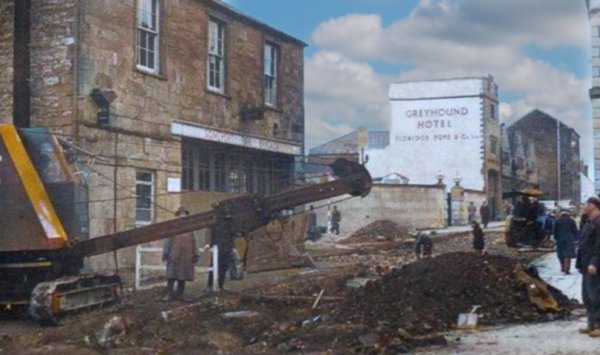
This colourised photograph, dating to about 1955, shows road works in South Street with the rebuilt Greyhound Hotel to the right, At left is the old Cheese Market building, converted in 1913 to the fire engine house.
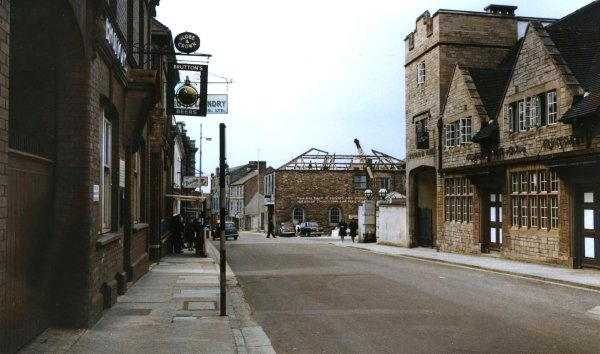 From the Cave
Collection
(colourised),
Courtesy of South Somerset Heritage Collection
From the Cave
Collection
(colourised),
Courtesy of South Somerset Heritage Collection
This photograph, taken during the 1960's, shows the Greyhound at right and the Globe and Crown at extreme left and at centre the demolition of the Fire Station, formerly the old Cheese Market in South Street.
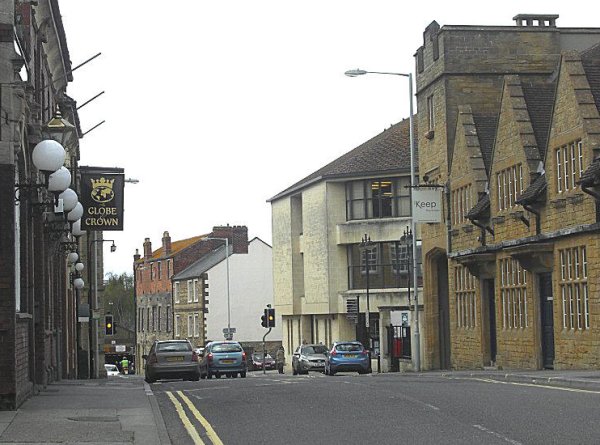
The same scene in 2012 - only the Globe and Crown remains - the Greyhound Hotel, Cow Inn, Market House Inn, King's Arms 2 and the Three Choughs Hotel have all gone.
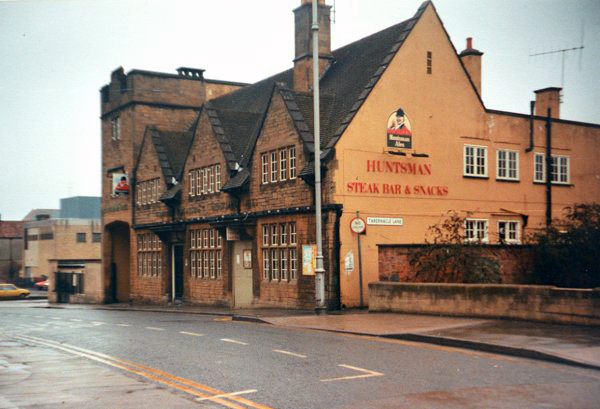
Courtesy of
Chris Rendell
The Greyhound photographed in 1983.
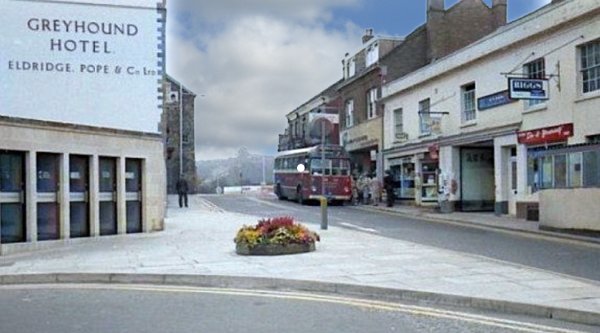
Looking at the other side of the Greyhound in the 1960's, before the poor dangling dog (see below) was added. King George Street still had traffic and the telephone kiosks are shown - it wasn't until my son asked what they were that I realised they had gone and it's just a plain wall again - see the 1955 photo above (just goes to show how observant I am).
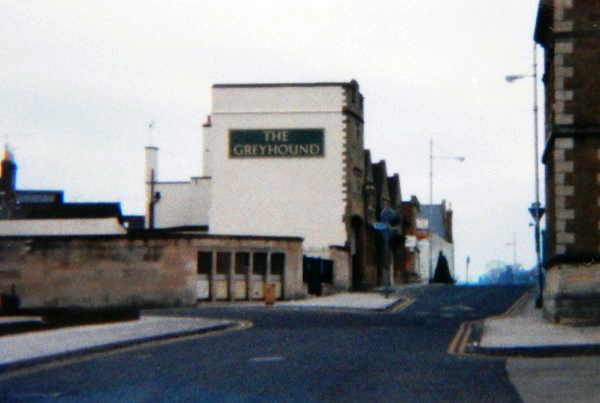
Courtesy of
Colin Haine
Photographed from Petters Way in the mid-1980s.
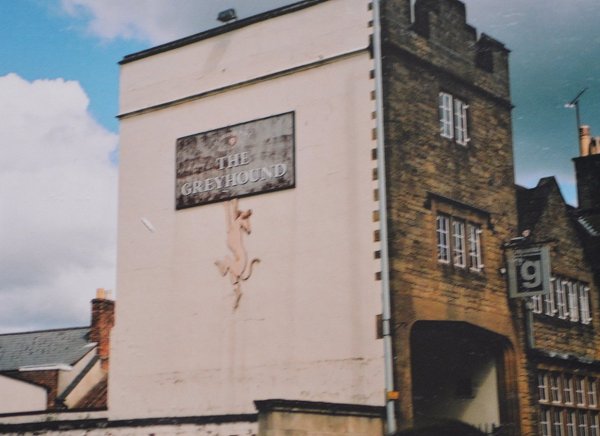
... and then the dangling dog appeared to be hanging from the sign on the flank wall.
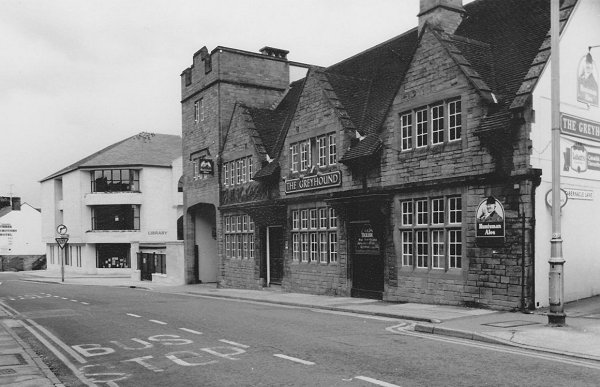
Photograph by
Trevor Hussey,
courtesy of Mrs
Anne Hussey
Photographed in 1990.
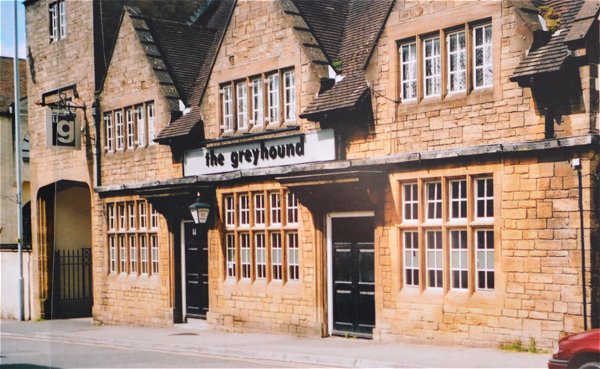
Courtesy of
Vivien and John
Cornelius
The Greyhound, photographed in May 2003.
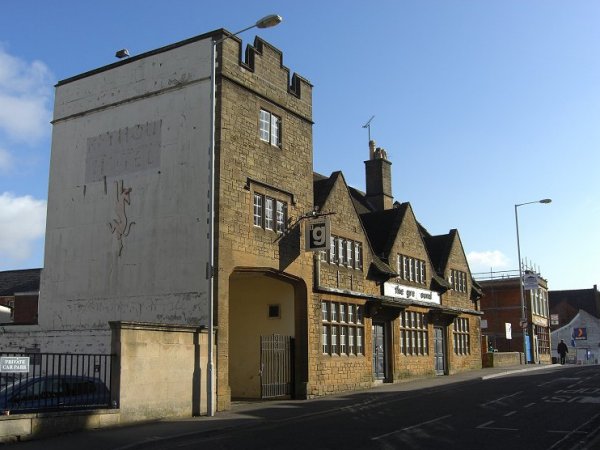
After it closed the building was left empty for many years. The poor dog was still left dangling on the side wall even though the sign had been removed. Photographed in 2009.
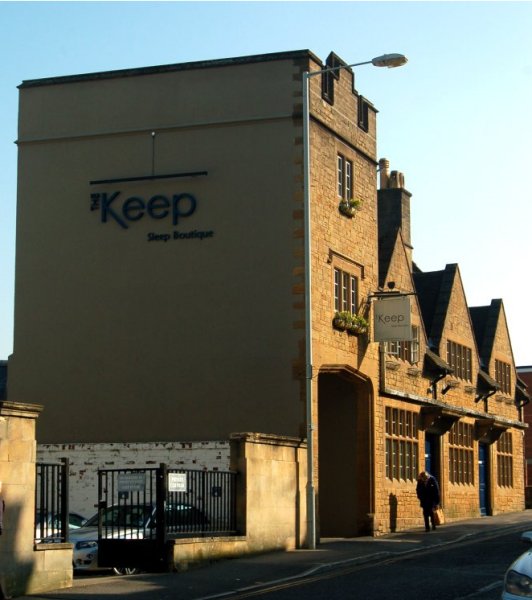
Photographed March 2013. It has recently been renovated and has opened as "The Keep" sleep boutique (yes, really!).
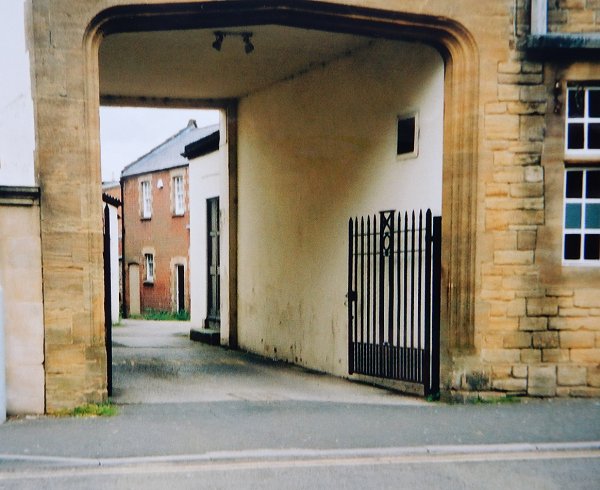
Courtesy of
Vivien and John
Cornelius
Looking through the Greyhound's porte-cochere to glimpse the Yeovil red brick houses of Greyhound Yard. Photographed in 2003.
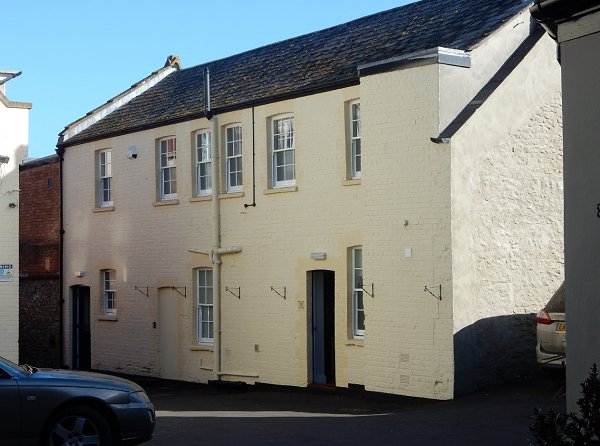
Photographed in 2015 - off-white paint now covers the lovely old Yeovil red bricks and Ham stone dressings. Shame.
licensees
1850 – Job
Osment – Beer
Retailer (Hunt &
Co's 1850
Directory)
1851 – Job
Osmond -
Licensed
Victualler (1851
census)
1852 – Job
Osment – Inn
Keeper (Slater’s
1852 Directory)
1861 – John
Lavor –
Victualler (1861
census) pub not
named
1861 – Robert
Allen (Kelly's
1861 Directory -
Inns & Hotels)
1871 – Robert
Allen –
Innkeeper (1871
census)
1872 – Robert
Allen (Kelly's
1872 Directory -
Hotels & Inns)
1875 – Robert
Allen (Kelly's
1871 Directory -
Hotels & Inns)
1879 – R McAulay
(Advertisement
in Whitby's
Almanack
Advertiser)
1880 – R McAulay
(Whitby's Yeovil
Almanack
Advertiser 1880)
1881 – Jane
McAulay – Wife
of Hotel Keeper
(1881 census)
1885 – Hugh
Marsh - license
transfer (Petty
Sessions,
January)
1885 – Charity
Braine - license
transferred
(Petty Sessions,
January)
1889 – Charity
Braine (Kelly’s
1889 Directory)
listed as
Greyhound Inn
1891 – Charity
Brain (56 year
old widow) –
Licensed
Victualler (1891
census)
Greyhound Inn
1895 – Charity
Braine (Kelly’s
1895 Directory)
listed as
Greyhound PH
1897 – Annie
Braine (Kelly’s
1897 Directory)
listed as
Greyhound PH
1901 – Annie
Langdon – Inn
Keeper (1901
census) listed
as Greyhound Inn
1911 – Annie
Langdon – Hotel
Proprietor (1911
census) listed
as Greyhound
Hotel
1914 – Annie
Langdon (Kelly’s
1914 Directory)
listed as
Greyhound PH
1923 – Annie
Langdon (Kelly’s
1923 Directory)
listed as
Greyhound PH
1936 – P Hawkins
(1936 Yeovil
Directory)
listed as
Greyhound
1939 – Percy
Hawkins (Kelly’s
1939 Directory)
listed as
Greyhound Hotel
1947 – P Hawkins
(1947 Yeovil
Directory)
listed as
Greyhound
1949 – P Hawkins
(Kelly’s 1949
Directory)
listed as
Greyhound
1951 – P Hawkins
(1951 Yeovil
Directory)
listed as
Greyhound
1954 – P Hawkins
(1954 Yeovil
Directory)
listed as
Greyhound
1957 – Licensee
not named (1957
Yeovil
Directory)
listed as
Greyhound
1960 – A Palmer
(1960 Yeovil
Directory)
listed as
Greyhound
1965 – Licensee
not named (1965
Yeovil
Directory)
listed as
Greyhound
1968 – Licensee
not named
(Kelly’s 1968
Directory)
listed as
Greyhound Hotel
1969 – Licensee
not named
(Kelly’s 1969
Directory)
listed as
Greyhound Hotel
1970 – Licensee
not named
(Kelly’s 1970
Directory)
listed as
Greyhound Hotel
1971 – Licensee
not named
(Kelly’s 1971
Directory)
listed as
Greyhound Hotel
1972 – Licensee
not named
(Kelly’s 1972
Directory)
listed as
Greyhound Hotel
1973 – Licensee
not named
(Kelly’s 1973
Directory)
listed as
Greyhound Hotel
1974 – Licensee
not named (1974
Yeovil
Directory)
listed as
Greyhound Hotel